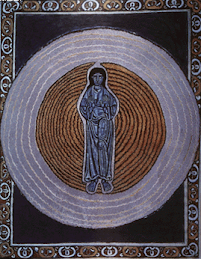The whole life of Christ was a continual Passion; others die martyrs but Christ was born a martyr. He found a Golgotha (where he was crucified) even in Bethlehem. Where he was born; for to his tenderness then the straws were almost as sharp as the thorns after, and the manger as uneasy at first as the cross at last. His birth and his death were but one continual act, and his Christmas day and his Good Friday are but evening and morning of one and the same day.- The Showing Forth of Christ, a Christmas Sermon (The Showing Forth of Christ, Sermons of John Donne, selected and edited by Edmund Fuller)
And here is one of Donne's poems exploring a similar theme:
Upon The Annunciation and Passion Falling Upon One Day.
(March 25th, 1608)
Tamely, frail body, abstain to-day; to-day
My soul eats twice, Christ hither and away.
She sees Him man, so like God made in this,
That of them both a circle emblem is,
Whose first and last concur; this doubtful day
Of feast or fast, Christ came, and went away.
She sees Him nothing, twice at once, who’s all;
She sees a Cedar plant itself, and fall;
Her Maker put to making, and the Head
Of life, at once, not yet alive, yet dead.
She sees at once the Virgin Mother stay
Reclused at home, public at Golgotha;
Sad and rejoiced she’s seen at once, and seen
At almost fifty, and at scarce fifteen.
At once a Son is promised her, and gone;
Gabriell gives Christ to her, He her to John;
Not fully a mother, She’s in orbity [bereavement];
At once receiver and the legacy.
All this, and all between, this day hath shown,
Th’ abridgement of Christ’s story, which makes one–
As in plain maps, the furthest west is east–
Of th’ angels Ave, and Consummatum est.
How well the Church, God’s Court of Faculties
Deals, in sometimes, and seldom joining these!
As by the self-fix’d Pole we never do
Direct our course, but the next star thereto,
Which shows where th’other is, and which we say
–Because it strays not far–doth never stray;
So God by His Church, nearest to Him, we know
And stand firm, if we by her motion go;
His Spirit, as His fiery pillar, doth
Leade, and His Church, as cloud; to one end both.
This Church, by letting those days join, hath shown
Death and conception in mankind is one;
Or ’twas in Him the same humility,
That He would be a man, and leave to be;
Or as creation He hath made, as God,
With the last judgement, but one period,
His imitating Spouse would join in one
Manhood’s extremes: He shall come, He is gone;
Or as though one blood drop, which thence did fall,
Accepted, would have served, He yet shed all,
So though the least of His pains, deeds, or words,
Would busy a life, she all this day affords;
This treasure then, in gross, my soul, uplay,
And in my life retail it every day.





4 comments:
Thanks very much for these daily "Twelve-Days-of-Christmas" postings!
They've been a great read, and a terrific way to start each day in Christmastide....
Donne's theme and reflections in this sermon and poem are a healthy antidote to the unhealthy tendency that Christians sometimes exhibit when they ruminate upon the crucifixion of Jesus and identify that single afternoon, and its physical extremities and tortures, as the Cross, rendering an image that can cross over into the sado/masochistic. The gospels themselves do not dwell on the physical details of the crucifixion because the deep theological truth is that Jesus' life in its entirety was his Passion. Conversely, celebrating Christmas without remembering the Passion leads to a banal and sentimental diminution of who Jesus was and what he came to undertake. The Passion and Incarnation are inextricably connected and can't be separated without distorting one or the other.
bls,
I am glad you enjoyed these. Thanks for stopping by.
Robert F,
Good observations. I suspect something like this is what Paul means when he encourages us to present ourselves as living sacrifices acceptable to the Lord.
Post a Comment